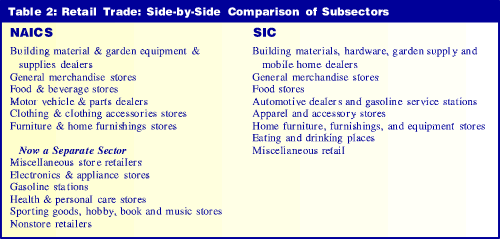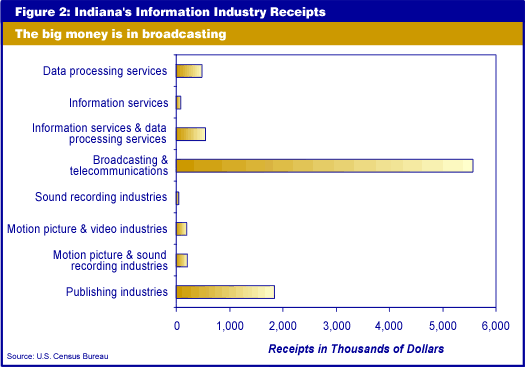Changing the Way We View our Economies: The North American Industry Classification System (NAICS)
Second in the NAICS Series
The way in which economists, government officials and economic developers speak and write about the economy will change over the next 12 to 24 months. New words will be used to describe new industry sectors, resulting from the federal government's new way of classifying business and industry in America—the North American Industry Classification System. Essentially, businesses that use similar production processes will be grouped together. Soon, we will hear monthly, quarterly and annual measures of industry employment and wages for sectors such as information, professional and scientific, health and social assistance, and even gambling (the legal variety, that is).
While the previous issue of IN Context provided an overview of the new structure, this time out we will look at a few specific sectors. Based on what we've learned from the Economic Census, the manufacturing, retail and wholesale sectors seem to have shrunk. Well, it's a little like the before and after photographs in weight loss commercials—much of the change depends on camera angle or point-of-view. In this case, one picture (SIC) shows the product, and the other picture (NAICS) shows the process.
Table 1 shows the net effect of changes in classification—moving and re-defining industries within sectors and out of sectors—for three major industries: manufacturing, wholesale trade and retail trade.

The retail sector shows nearly 180,000 fewer jobs under NAICS than under SIC. This is probably the best example of why it will be difficult, if not impossible, to compare NAICS-based data to SIC-based data. The newly defined retail trade sector no longer includes eating and drinking establishments (see Table 2).

Manufacturing: It's In the Making
Under NAICS, establishments engaged in the mechanical, physical or chemical transformation of materials, substances or components into new products are grouped in manufacturing. This sector has 79 new industries and another 186 were revised. In all, there are 474 NAICS industries in manufacturing, compared with 459 under SIC. The most significant change to manufacturing was the creation of the Computer and Electronic Product Manufacturing subsector, bringing together establishments engaged in the production of computers, computer peripherals, communications equipment, similar electronic products, and the components for such products.
Out: Publishing has moved to the new Information sector. Logging is now part of Agriculture, Forestry and Fishing.
In: Bakeries and candy stores where the products are made on the premises, custom tailors, makers of custom draperies and tire retreaders.
The Fuzzy Line Between Retail and Wholesale Trade
The boundaries between retail and wholesale have changed significantly, because NAICS emphasizes what the establishment does rather than to whom it sells. Retailers are now defined as establishments that sell merchandise, generally without transformation, and attract customers using methods such as advertising, point-of-sale location and display of merchandise. A store retailer has a selling place open to the public, merchandise on display or available through sales clerks, facilities for making cash or credit card transactions, and services provided to retail customers.
Wholesale establishments are mostly engaged in selling or arranging the purchase or sale of goods for resale, capital or durable nonconsumer goods, and raw and intermediate materials and supplies used in production. Wholesalers normally operate from a warehouse or office and are characterized by having little or no display of merchandise. In addition, neither the design nor the location of the premises is intended to solicit walk-in traffic. Wholesalers also don't usually advertise to the general public.
The SIC defined retailers as those establishments that sold primarily to consumers while wholesalers were those establishments that sold primarily to business customers. The distinction between the boundaries of the two SIC divisions was based on class of customer rather than the selling characteristics of the establishment. The Census Bureau estimates that seven percent of computer wholesalers, 22 percent of office supply wholesalers, 35 percent of farm supply wholesalers and 57 percent of petroleum bulk stations will move to retail.
Restaurants, Bars and Coffee Houses
Another major change to the retail trade sector is the removal of restaurants from retail trade. Restaurants are combined with accommodations (hotels, motels, bed & breakfast inns, etc.) to form a new sector in NAICS, Accommodation and Foodservices. Under SIC, restaurants accounted for about 10 percent of retail trade.
Information Defined for the Information Age
One of the most important changes in NAICS is the recognition of a new Information sector. Information includes establishments that create, disseminate or provide the means to distribute information. It also includes establishments that provide data processing services (see Figures 1 and 2). Specific industries include:
- Newspaper, book and periodical publishers, previously included in the manufacturing sector
- Software publishers, previously included in services
- Broadcasting and telecommunications producers and distributors, previously included with utilities and transportation
- Motion picture and sound recording industries, information services and data processing services, previously included in services


There are 34 industries included in this new subsector, and 20 are new. Among the new industries are satellite telecommunications and paging, cellular and other wireless telecommunications.
The FIRE is Out
Real estate, once part of the Finance, Insurance and Real Estate (FIRE) triumvirate, is now part of the Real Estate and Rental and Leasing sector and now includes industries that used to be part of Services; Finance, Insurance, and Real Estate; and Transportation, Communications, and Public Utilities.
Professional, Scientific and Technical Services
Those businesses whose major input is human capital are now grouped together. The industries within this sector are each defined by the expertise and training of the service provider. This sector includes such industries as offices of lawyers, engineering services, architectural services, advertising services, veterinary services and interior design services. Forty-seven industries are grouped in this sector, 28 of which are new.
Administrative and Support; Waste Management and Remediation Services
This sector includes industries from Services; Transportation, Communications, and Utilities; Construction; and Agriculture, Forestry, and Fishing.
Health and Social Assistance
Recognizing that it is sometimes difficult to distinguish between the boundaries of health care and social assistance, NAICS has grouped these industries in order from those providing the most intensive type of health care to those providing minimal health care with social assistance to providing only social assistance. There are 39 industries in this new sector, 27 of which are new, including HMOs, Family Planning Centers, Blood and Organ Banks, Diagnostic Imaging Centers, Continuing Care Retirement Communities, and Community Food Services. This sector also includes ambulance services which was previously a part of Transportation, Communications, and Public Utilities.
Gambling, Movies and Museums
The new Arts, Entertainment, and Recreation sector includes businesses engaged in meeting the cultural, entertainment and recreational interests of their patrons. Notably, legal casinos and other gambling businesses are recognized for the first time in NAICS, as are historical sites and sports teams. In all, there are 25 industries in the sector, most of which are new.
Enough already!
The changes are big, and the task of explaining them in ways we all can grasp seems even bigger. Next issue of IN Context we will tackle Auxiliaries, excluding Corporate, Subsidiary, and Regional Managing Offices and the category Management of Companies and Enterprises. For the impatient reader, all source material can be found on the web at www.census.gov/epcd/www/naics.html. Feel free to email rogersc@iu.edu with questions about this article.
